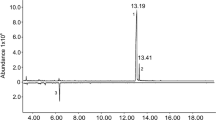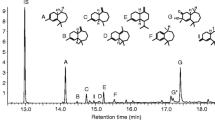Abstract
The bearded weevil, Rhinostomus barbirostris (Coleoptera: Curculionidae: Dryophthorinae), attacks coconut trees, oil palms and other species of Arecaceae. Besides direct damage, R. barbirostris may be a vector of diseases in coconut and oil palms, such as stem bleeding (resinosis) and red ring disease. Currently, the only method to control this weevil is by visual observation of damage and removal of infected plants. Semiochemical-based trapping could improve the effectiveness of monitoring and management of R. barbirostris. In comparisons of volatiles released by R. barbirostris males and females by gas chromatography (GC) two male-specific compounds were observed. GC-mass spectrometry (MS) and GC-Fourier transform-infrared (FTIR) analyses of the natural compounds suggested these were diastereoisomers of 5-hydroxy-4-methylheptan-3-one, also known as sitophilure, a pheromone component of other dryophthorine species. Synthesis of the mixture of all four stereoisomers of sitophilure was performed in two steps, and the chemical structures were confirmed by comparing GC retention times and MS and FTIR spectra of natural and synthetic compounds. The absolute configurations of the two male-specific compounds were elucidated by enantioselective GC; the major component was the (4S,5R)-isomer, and the minor component (4S,5S)-sitophilure. In analyses by GC-electroantennography (EAG) the antennae of male and female R. barbirostris only responded to the (4S,5R)-isomer of the synthetic sitophilure. The stereoisomeric mixture of sitophilure was attractive to both sexes of R. barbirostris in laboratory experiments in the presence of sugar cane volatiles, and a similar result was obtained in a preliminary field trapping test.






Similar content being viewed by others
References
Allou K, Morin J-P, Kouassi P, N’klo FH, Rochat D (2006) Oryctes monoceros trapping with synthetic pheromone and palm material in Ivory Coast. J Chem Ecol 32:1743–1754
Ambrogi B, Zarbin P (2008) Aggregation pheromone in Sternechus subsignatus (Coleoptera: Curculionidae): olfactory behaviour and temporal pattern of emission. J Appl Entomol 132:54–58
Ambrogi BG, Vidal DM, Zarbin PHG, Rosado-Neto GH (2009) Aggregation pheromone in Curculionidae (Insecta: Coleoptera) and their taxonomic implication. Quim Nova 32:2151–2158
Beauhaire J, Ducrot PH, Malosse C, Rochat D, Ndiege IO, Otieno DO (1995) Identification and synthesis of sordidin, a male pheromone emitted by Cosmopolites sordidus. Tetrahedron Lett 36(7):1043–1046
Coates J (2000) Interpretation of infrared spectra, a practical approach. In: Meyers RA (ed) Encyclopedia of analytical chemistry. John Wiley & Sons Ltd, Chichester, pp 10815–10837
Duarte AG, ISd L, Navarro D, Sant’Ana AEG (2003) Trap catches of Rhynchophorus palmarum L. (Coleoptera: Curculionidae) baited with its aggregation pheromone and volatile compounds from pineapple. Rev Bras Frutic 25:81–84
Fávaro CF, Millar JG, Zarbin PHG (2015) Identification and synthesis of the male-produced sex pheromone of the stink bug, Pellaea stictica. J Chem Ecol 41:859–868
Ferreira JMS (1987) Proteção fitossanitária do coqueiral. III. Controle de pragas no campo. Empresa Brasileira de Pesquisas Agropecuárias-EMBRAPA, Aracajú
Ferreira JMS, Fontes HR (2006) Produção integrada de coco: identificação de pragas, doenças e desordem nutricionais e fisiológicas. Empresa Brasileira de Pesquisas Agropecuárias-EMBRAPA, Aracajú
Guimarães CAL, Moura JIL (2014) Trap for the capture of Strategus aloeus L. (Coleoptera: Scarabaeidae) pest of Arecaceae. Agrotrópica 26:139–142
Kalaitzakis D, Rozzell JD, Kambourakis S, Smonou I (2006) A two-step chemoenzymatic synthesis of the natural pheromone (+)-sitophilure utilizing isolated, nadph-dependent ketoreductases. Eur J Org Chem 10:2309–2313
Lubeck AJ, Sutton DL (1983) Kovats retention indices of selected hydrocarbons through C10 on bonded phase fused silica capillaries. J Sep Sci 6:328–332
Morin J-P, Ps S, Purba RY, Desmier De Chenon R, Kakul T, Laup S, Beaudoin-Ollivier L, Rochat D (2001) A new type of trap for capturing Oryctes rhinoceros (Scarabaeidae, Dynastinae), the main pest in young oil palm and coconut plantings. Brazilian Journal of Agriculture 17:13–22
Moura JIL (2017) Manejo integrado das pragas das palmeiras. Ceplac/Esmai, Ilhéus. http://www.ceplac.gov.br/paginas/publicacoes/paginas/cartilhas_tecnicas/cartilhas/MIPP.pdf
Moura JIL, de Oliveira ML, Luz EDMN, Silva SDVM, Santos RS (2013) Weevil associated to gummosis in oil palm (Elaeis guineensis Jacq.) in Brazil. Braz J Agric 88:87–89
Oehlschlager AC (2016) Palm weevil pheromones – discovery and use. J Chem Ecol 42:617–630
Oehlschlager AC, Pierce HD, Morgan B et al (1992) Chirality and field activity of Rhynchophorol, the aggregation pheromone of the American palm weevil. Naturwissenschaften 79:134–135
Perez AL, Gries G, Gries R, Giblin-Davis RM, Oehlschlager AC (1994) Pheromone chirality of the African palm weevil, Rhynchophorus phoenicis (F.) and the palmetto weevil, Rhynchophorus cruentatus (F.), (Coleoptera: Curculionidae). J Chem Ecol 20:2653–2671
Perez AL, Hallett RH, Gries R, Gries G, Oehlschlager AC, Borden JH, Gonzalez LM (1996) Pheromone chirality of the Asian palm weevils, Rhynchophorus ferrugineus (Oliv.) and Rhynchophorus vulneratus (Panz.). J Chem Ecol 22:357–368
Phillips J, Walgenbach C, Klein J, Burkholder W, Schmuff N, Fales H (1985) (R*, S*)-5-hydroxy-4-methyl-3-heptanone male-produced aggregation pheromone of Sitophilus oryzae (L.) and S. zeamais motsch. J Chem Ecol 11:1263–1274
Silverstein RM, Webster FX, Kiemle DJ, Bryce DL (2014) Spectrometric identification of organic compounds. John Wiley & Sons, New York
Smith AB, Levenberg PA (1981) Oxidation of β-hydroxyketones and esters: a convenient synthesis of 1, 3-diketones and β-ketoesters. Synthesis 1981(07):567–570
Unelius CR, Park KC, McNeill M, Wee SL, Bohman B, Suckling DM (2013) Identification and electrophysiological studies of (4S,5S)-5-hydroxy-4-methyl-3-heptanone and 4-methyl-3,5-heptanedione in male lucerne weevils. Naturwissenschaften 100:135–143
Uzakah R, Odebiyi J, Chaudhury M, Hassanali A (2015) Evidence for the presence of a female produced sex pheromone in the banana weevil Cosmopolites sordidus Germar (Coleoptera: Curculionidae). Sci Res Essays 10:471–481
Vacas S, Navarro I, Seris E, Ramos C, Hernández E, Navarro-Llopis V, Primo J (2017) Identification of the male-produced aggregation pheromone of the four-spotted coconut weevil, Diocalandra frumenti. J Agric Food Chem 65(2):270–275
Walgenbach CA, Phillips JK, Burkholder WE, King G, Slessor KN, Mori K (1987) Determination of chirality in 5-hydroxy-4-methyl-3-heptanone, the aggregation pheromone of Sitophilus oryzae (L.) and S. zeamais Motschulsky. J Chem Ecol 13:2159–2169
Weissling T, Giblin-Davis R, Gries G, Gries R, Perez AL, Oehlschlager AC, Pierce HD Jr (1994) Field activity of the male-produced aggregation pheromone of the sabal palm weevil, Rhynchophorus cruentatus. J Chem Ecol 20:505–515
Zarbin PH, Moreira MA, Haftmann J, Francke W, Oliveira AR (2007) Male-specific volatiles released by the brazilian papaya weevil, Pseudopiazurus obesus: partial identification and evidence of an aggregation pheromone. J Braz Chem Soc 18:1048–1053
Acknowledgements
We thank the Coordination for Improvement of Higher Education Personnel (CAPES), the State of Bahia Research Foundation (FAPESB) and the National Institute of Science and Technology (INCT) Semiochemicals in Agriculture (CNPq Process 465511/2014-7 and FAPESP Process 2014/50871-0) for supporting research. We also thank Dr. Jeffrey R. Aldrich for his help in improving the English language corrections, and the Professors of the State University of Santa Cruz (UESC), Ivon Lobo and Rosenira Serpa, for assisting the GC-FID analyses, and Rosilene de Oliveira for preliminary GC-MS analyses.
Author information
Authors and Affiliations
Corresponding author
Rights and permissions
About this article
Cite this article
Reis, A.C., Neta, P.L.S., Jordão, J.P. et al. Aggregation Pheromone of the Bearded Weevil, Rhinostomus barbirostris (Coleoptera: Curculionidae): Identification, Synthesis, Absolute Configuration and Bioactivity. J Chem Ecol 44, 463–470 (2018). https://doi.org/10.1007/s10886-018-0957-x
Received:
Revised:
Accepted:
Published:
Issue Date:
DOI: https://doi.org/10.1007/s10886-018-0957-x




